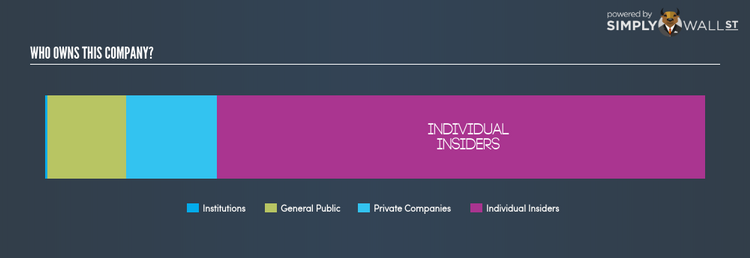Should You Be Concerned About Broo Limited’s (ASX:BEE) Shareholders?

In this analysis, my focus will be on developing a perspective on Broo Limited’s (ASX:BEE) latest ownership structure, a less discussed, but important factor. Ownership structure has been found to have an impact on shareholder returns in both short- and long-term. Since the effect of an active institutional investor with a similar ownership as a passive pension-fund can be vastly different on a company’s corporate governance and accountability of shareholders, investors should take a closer look at BEE’s shareholder registry.
View our latest analysis for Broo
Institutional Ownership
Due to the big order sizes of institutional investors, a company’s shares can experience large, one-sided momentum, driven by high volume of shares removed from, or injected into, the market. With hardly any institutional ownership, BEE stock poses limited concern relating to the effect institutional block trades have on its stock price.
Insider Ownership
I find insiders are another important group of stakeholders, who are directly involved in making key decisions related to the use of capital. In essence, insider ownership is more about the alignment of shareholders’ interests with the management. A major group of owners of BEE is individual insiders, sitting with a hefty 73.88% stake in the company. Broadly, insider ownership of this level has been found to negatively affect companies with consistently low PE ratio (underperforming). And a positive impact has been seen on companies with a high PE ratio (outperforming). It may be interesting to take a look at what company insiders have been doing with their holdings lately. Insiders buying company shares can be a positive indicator of future performance, but a selling decision can simply be driven by personal financial needs.
General Public Ownership
A substantial ownership of 11.93% in BEE is held by the general public. With this size of ownership, retail investors can collectively play a role in major company policies that affect shareholders returns, including executive remuneration and the appointment of directors. They can also exercise the power to decline an acquisition or merger that may not improve profitability.
Private Company Ownership
Potential investors in BEE should also look at another important group of investors: private companies, with a stake of 13.78%, who are primarily invested because of strategic and capital gain interests. With this size of ownership in BEE, this ownership class can affect the company’s business strategy. As a result, potential investors should further explore the company’s business relations with these companies and find out if they can affect shareholder returns in the long-term.
Next Steps:
Institutional ownership in BEE is not at a level that would concern investors. We are less likely to see sustained downtrends or significant volatility resulting from large institutional trading. However, if you are building an investment case for BEE, ownership structure alone should not dictate your decision to buy or sell the stock. Instead, you should be evaluating company-specific factors such as the intrinsic valuation, which is a key driver of Broo’s share price. I highly recommend you to complete your research by taking a look at the following:
Financial Health: Is BEE’s operations financially sustainable? Balance sheets can be hard to analyze, which is why we’ve done it for you. Check out our financial health checks here.
Other High-Performing Stocks: Are there other stocks that provide better prospects with proven track records? Explore our free list of these great stocks here.
NB: Figures in this article are calculated using data from the last twelve months, which refer to the 12-month period ending on the last date of the month the financial statement is dated. This may not be consistent with full year annual report figures.
To help readers see pass the short term volatility of the financial market, we aim to bring you a long-term focused research analysis purely driven by fundamental data. Note that our analysis does not factor in the latest price sensitive company announcements.
The author is an independent contributor and at the time of publication had no position in the stocks mentioned.

 Yahoo Finance
Yahoo Finance 
